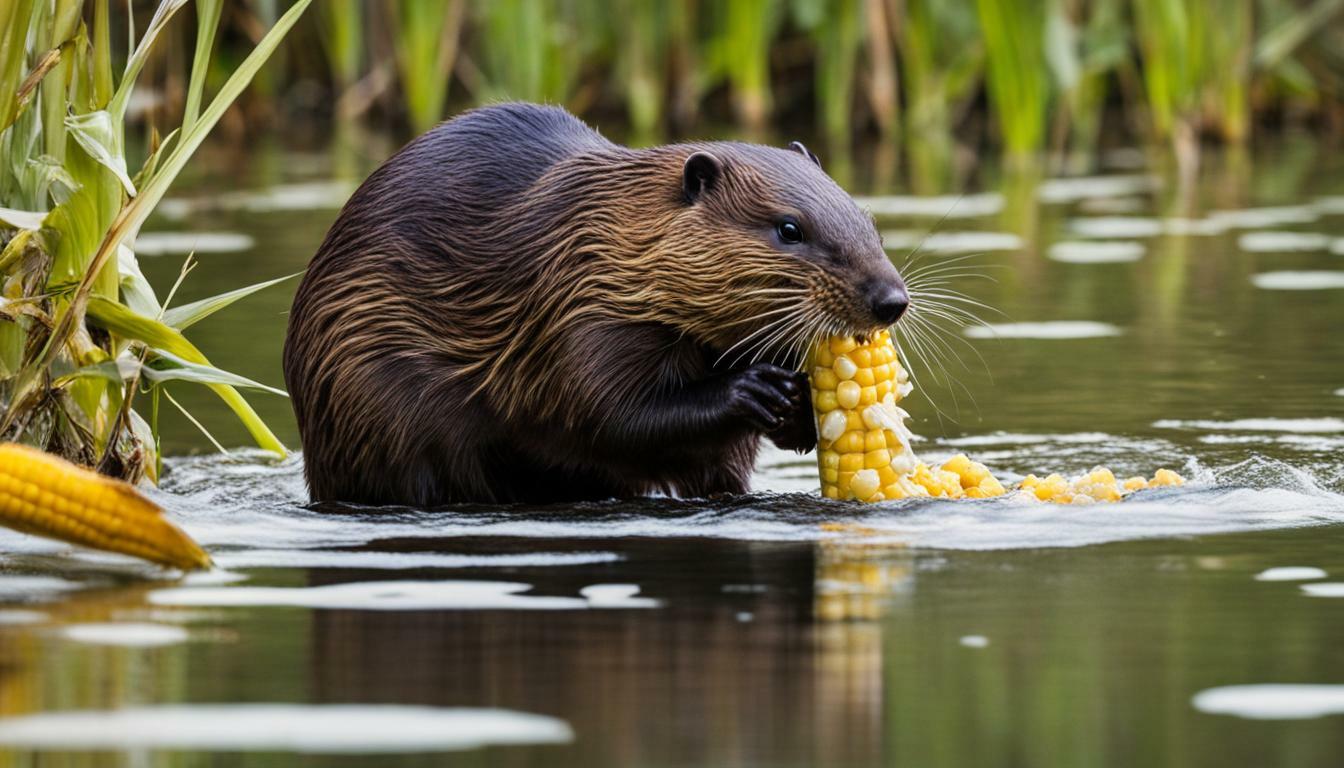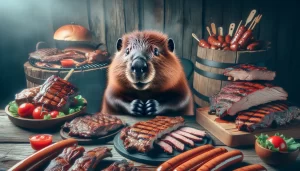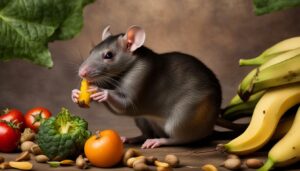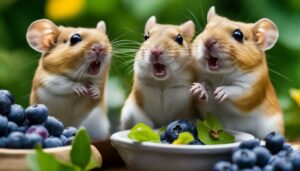Have you ever wondered if beavers eat corn? In this comprehensive guide, we will delve into the fascinating world of beavers’ dietary preferences and find out if corn is on their menu.
Key Takeaways:
- Beavers are known for consuming a variety of plant material, including corn, soybeans, and wheat.
- Their primary diet consists of bark, leaves, and twigs.
- Beavers’ consumption of corn can sometimes bring them into conflict with farmers.
- These adaptable creatures utilize different food sources to survive in their natural habitats.
- While not their main food source, corn can serve as a supplementary part of a beaver’s diet.
Understanding the Beaver Diet
Before exploring the specific question of whether beavers eat corn, it is important to understand the overall dietary preferences and feeding habits of these industrious creatures. Beavers are well-known for their ability to construct elaborate dams and lodges, but their diet plays a crucial role in their survival and habitat modification.
Beavers are primarily herbivores, with a diet consisting mainly of tree bark, leaves, and twigs. These resourceful animals use their sharp incisors to fell trees and strip away the outer layers of bark, which they consume as a source of nutrients. They also feast on a variety of aquatic plants, such as water lilies, sedges, and cattails, which they find in and around their wetland habitats.
| Primary Food Sources | Aquatic Vegetation |
|---|---|
| Tree bark | Water lilies |
| Leaves | Sedges |
| Twigs | Cattails |
However, beavers are adaptable creatures and will make use of different food sources depending on their availability. Farmers and landowners have reported instances of beavers consuming corn, soybeans, and wheat. These crops, planted near beaver habitats, can be particularly appealing to these creatures and often lead to conflicts between beavers and humans.
It is important to note that while beavers may consume corn on occasion, it is not a staple food in their diet. Their preference for tree bark and aquatic plants remains their main source of sustenance. The consumption of corn by beavers is more of a supplementary behavior, driven by factors such as proximity to their habitats and the availability of other food sources.
Beavers’ Food Preferences
While beavers are primarily known for their consumption of bark, leaves, and twigs, they also have a diverse range of food preferences. These industrious creatures are herbivores and rely on plant material to meet their nutritional needs. In addition to their main diet of woody vegetation, beavers have been observed consuming a variety of other plant materials.
Beavers are opportunistic feeders and adapt their food choices based on availability. They often consume aquatic plants such as water lilies, cattails, and sedges that grow near their habitat. They have also been known to munch on grasses, ferns, and mosses. In some cases, beavers have shown a preference for root vegetables like tubers, bulbs, and rhizomes.
Interestingly, beavers have a sweet tooth as well. They are attracted to the sugary goodness of fruits, particularly apples and berries. While corn is not a natural part of their diet, some farmers have reported beavers feasting on corn crops and hauling corn stalks into their ponds. This behavior can lead to conflicts between beavers and farmers, as it impacts agricultural practices.
| Beaver Food Preferences | Examples |
|---|---|
| Woody vegetation | Bark, leaves, twigs |
| Aquatic plants | Water lilies, cattails, sedges |
| Grasses, ferns, and mosses | – |
| Root vegetables | Tubers, bulbs, rhizomes |
| Fruits | Apples, berries |
| Corn (occasionally) | – |
It’s important to note that beavers primarily rely on woody vegetation for their sustenance. Their ability to selectively cut down trees and build intricate dams and lodges is a testament to their resourcefulness. By understanding the diverse food preferences of beavers, we can gain a greater appreciation for the adaptability and resilience of these fascinating creatures.
Farmers’ Reports on Beaver Activities
Farmers have reported instances of beavers cutting and hauling rows of corn stalks into their ponds, suggesting that corn may be a part of their diet. While beavers are primarily known for their tree-eating habits, these observations point to their adaptable nature when it comes to finding food sources. This behavior has raised questions about the extent of corn consumption by beavers and its implications for farmers.
Beavers are known to consume a variety of plant material, and their food choices can sometimes bring them into conflict with farmers. Corn, along with soybeans and wheat, is among the plant materials beavers have been observed consuming. The fact that beavers find corn appealing enough to cut and transport to their ponds indicates that it may play a role in their diet, although it is not their primary food source.
These reports highlight the need for farmers to be aware of the potential impact beavers can have on their agricultural practices. While beavers contribute to the ecosystem by creating wetlands that support a variety of wildlife, their consumption of crops like corn can pose challenges for farmers. Finding ways to mitigate these conflicts and protect agricultural yields is essential for both farmers and beaver conservation efforts.
| Plant Material | Primary Food Source? |
|---|---|
| Bark, Leaves, Twigs | Yes |
| Corn | No |
| Soybeans | No |
| Wheat | No |
Beavers’ ability to adapt and utilize different food sources is a testament to their survival instincts in their natural habitats. While corn consumption by beavers may not be their primary dietary choice, it emphasizes the need for understanding their behavior and developing strategies to manage potential conflicts between beavers and farmers.
Beavers and Conflicts with Farmers
Beavers’ dietary choices can sometimes bring them into conflict with farmers, particularly when they consume crops like corn, impacting agricultural yields. Farmers have reported instances where rows of corn stalks have been cut and hauled into beaver ponds, signaling the beavers’ preference for this particular crop. This can be problematic for farmers as it not only results in reduced corn production but also presents challenges in managing beaver populations.
While the primary diet of beavers consists of bark, leaves, and twigs, they are known to be opportunistic feeders and can adapt their food choices based on availability. This adaptability extends to consuming crops like corn, soybeans, and wheat when they are accessible. The allure of corn to beavers may be attributed to its high carbohydrate content and the ease of access to fields near water sources.
To address the conflicts between beavers and farmers, various strategies have been implemented. These include the installation of fences around crops, utilizing deterrents such as loud noises or flashing lights, and relocating beavers to more suitable habitats. However, finding a balance between protecting agricultural yields and preserving the natural behavior of beavers remains a challenge.
| Common Crops Consumed by Beavers | Frequency of Consumption |
|---|---|
| Corn | Occasional |
| Soybeans | Occasional |
| Wheat | Occasional |
It is important to note that while beavers may consume corn, it is not a staple food source for them. Their diet primarily consists of aquatic vegetation, inner bark of trees, and other plant materials. However, when beavers are in close proximity to agricultural areas, they may opportunistically sample crops like corn, leading to conflicts with farmers.
Adaptable Beavers
Beavers are known for their adaptability and ability to utilize a variety of food sources to survive in their natural habitats. While their primary diet consists of bark, leaves, and twigs, they have also been observed consuming other plant materials, including corn, soybeans, and wheat. This diverse food selection allows them to adapt to different environments and availabilities of food.
When it comes to their food choices, beavers display a preference for certain plant materials, while also being opportunistic eaters. They will consume various types of aquatic plants, as well as a range of trees and shrubs. The diet of beavers may vary depending on the specific habitat and the availability of food sources.
Beavers are equipped with strong jaws and sharp teeth, which enable them to cut down trees and gnaw through tough vegetation. They are capable of felling both deciduous and coniferous trees, using the logs for building dams and lodges. The branches and twigs serve as their primary food source, providing them with the necessary nutrients and roughage they need.
| Primary Food Sources | Preferred Plant Materials |
|---|---|
| Bark | Willow |
| Leaves | Aspen |
| Twigs | Pondweed |
While beavers do consume corn, it is important to note that it is not their only food source. Farmers and agriculturalists have reported instances of beavers cutting down corn stalks and transporting them to their ponds. However, beavers primarily consume corn as a supplementary food source rather than a staple in their diet. They are known to consume a variety of plant materials besides corn, as they have a diverse range of food preferences.
The Appeal of Corn to Beavers
What is it about corn that makes it an attractive food source for beavers? Let’s uncover the factors that might draw them to this particular crop.
Beavers are primarily herbivores, and their diet consists mainly of bark, leaves, and twigs. However, their food choices can vary depending on factors such as availability and the season. While corn is not a typical part of a beaver’s diet, it appears that they find it appealing for several reasons.
One factor could be the high sugar content of corn. Beavers have a preference for foods that are rich in carbohydrates, and corn provides them with a good source of energy. The sweetness of the corn may be particularly enticing to beavers, leading them to consume it when other food sources are scarce.
| Factors that make corn appealing to beavers: |
|---|
| Corn’s high sugar content provides beavers with energy. |
| Beavers are attracted to the taste and texture of corn on the cob. |
| Corn can be easily accessible for beavers, especially in agricultural areas. |
In addition to the sugar content, beavers may also be attracted to the taste and texture of corn on the cob. The crunchiness and juiciness of the corn could make it a satisfying food source for them.
Furthermore, the accessibility of corn may play a role in beavers’ preference for it. Corn is often grown in agricultural areas, which can be close to beaver habitats. This proximity makes it easier for beavers to access and consume corn when they come across it.
While corn consumption by beavers can lead to conflicts with farmers, it is important to understand that beavers are adaptable creatures. Their ability to utilize different food sources is a testament to their survival skills in various habitats.
As farmers continue to find evidence of beavers consuming corn, it is essential to explore strategies for coexistence. By understanding the factors that make corn appealing to beavers, farmers can better implement measures to protect their crops while also preserving the natural behaviors and habitats of these fascinating creatures.
Other Food Sources for Beavers
While beavers may eat corn, it is important to understand that their diet consists of a wide range of plant materials, beyond just this crop. These semi-aquatic mammals have been observed consuming various plants, which play a crucial role in their survival and habitat maintenance.
One of the primary food sources for beavers is bark, specifically the inner bark of trees. This provides them with essential nutrients and helps to keep their ever-growing incisors in check. Beavers also feed on leaves, twigs, and small branches, which are readily available in their natural habitats.
Table: Common Plant Materials Consumed by Beavers
| Plant Material | Availability | Significance |
|---|---|---|
| Alder, Willow, and Poplar | Abundant in riparian zones | Primary food sources for beavers |
| Cattails and Water Lilies | Found in wetland areas | Supplemental food sources |
| Soybeans | Cultivated by farmers | Can cause conflicts with agriculture |
| Wheat and Grasses | Common in open fields | Alternative food sources in certain regions |
Beavers’ ability to adapt to different food sources is evident in their consumption of soybeans and wheat, which can sometimes bring them into conflict with farmers. These crops, cultivated by humans, are often found near beaver habitats and can become attractive food options for these industrious creatures.
Overall, while corn may be a supplementary food source for beavers, it is crucial to recognize that their diet comprises a diverse selection of plant materials. By understanding their feeding habits and food preferences, we can better coexist with these fascinating animals and minimize conflicts between beavers and agricultural practices.
Corn as a Supplementary Food Source
While corn may not be a staple food for beavers, it can serve as a supplementary source of sustenance for these industrious creatures. Farmers have reported instances where beavers have been observed consuming corn, adding it to their diverse diet. Beavers are known for their ability to adapt to different environments, utilizing a variety of plant materials to meet their nutritional needs. Alongside their primary diet of bark, leaves, and twigs, beavers have been observed consuming corn, soybeans, and wheat.
These additional food sources can sometimes lead to conflicts between beavers and farmers, as the beavers’ foraging habits can damage agricultural crops. Farmers have reported finding rows of corn stalks cut and transported into beaver ponds, highlighting the beavers’ affinity for corn. However, it is important to note that corn consumption by beavers is not as widespread as their consumption of other plant materials. The beavers’ ability to adapt their diet to different food sources allows them to survive and thrive in their natural habitats.
Overall, while corn may not be a beaver’s go-to food choice, it can play a supplementary role in their diet. The varied dietary habits of beavers demonstrate their resourcefulness and ability to find sustenance in different environments. By understanding their food preferences and behaviors, efforts can be made to manage beaver populations and mitigate potential conflicts with farmers. Observing and studying the beavers’ diet helps us gain insight into their ecological role and the fascinating ways they interact with their surroundings.
| Type of Food | Examples |
|---|---|
| Primary Diet | Bark, leaves, twigs |
| Supplementary Food | Corn, soybeans, wheat |
Conclusion
In conclusion, while beavers are primarily known for their consumption of bark, leaves, and twigs, they have been observed eating corn on the cob, albeit as part of a diverse diet. Farmers have reported finding rows of corn stalks cut and hauled into beaver ponds, indicating that corn consumption is not uncommon for these industrious creatures.
Beavers are adaptive and resourceful, able to utilize a variety of plant materials to meet their nutritional needs. Alongside corn, they also consume soybeans and wheat, further expanding their dietary choices. However, their consumption of crops like corn can sometimes lead to conflicts with farmers, who rely on these plants for agricultural purposes.
Despite their ability to consume corn, it is important to note that it is not their primary food source. Beavers primarily rely on the fibrous bark of trees, as well as leaves and twigs, which provide essential nutrients for their survival. Corn is more likely to be consumed as a supplementary item when other food sources are limited or unavailable.
Overall, understanding the beaver’s diet is crucial in managing the interactions between these fascinating creatures and human activities. By implementing strategies that promote coexistence, such as utilizing fencing or alternative food sources, farmers can mitigate conflicts and protect their crops while allowing beavers to thrive in their natural habitats.
FAQ
Do beavers eat corn?
Yes, beavers have been observed eating corn on the cob. While their primary diet consists of bark, leaves, and twigs, beavers are adaptable and able to utilize different food sources to survive in their natural habitats. This includes consuming corn, soybeans, and wheat.
What is the beaver’s primary diet?
The beaver’s primary diet consists of bark, leaves, and twigs. They are herbivores and rely on plant material for sustenance.
What other plant materials do beavers consume?
Besides corn, beavers also consume a variety of plant materials, such as soybeans and wheat. They have a wide range of food preferences and adapt to their environment to find suitable food sources.
Have farmers reported beavers eating corn?
Yes, farmers have reported finding rows of corn stalks cut and hauled into beaver ponds. Beavers’ consumption of corn can sometimes bring them into conflict with farmers, as they rely on crops for their livelihood.
Why do beavers consume corn?
Beavers may be attracted to corn due to its availability and nutritional value. Corn provides a good source of energy and nutrients for the beavers, making it appealing to them.
What other conflicts arise between beavers and farmers?
Besides consuming crops like corn, beavers may also cause damage to irrigation systems, trees, and other agricultural infrastructure. This can lead to financial losses and challenges for farmers in managing beaver populations.
Are beavers adaptable when it comes to food sources?
Yes, beavers are highly adaptable and can utilize different food sources depending on their habitat. While their primary diet consists of bark, leaves, and twigs, they are able to incorporate other plant materials, including corn, soybeans, and wheat, into their diet if available.
Besides corn, what other plant materials do beavers eat?
In addition to corn, beavers consume a variety of plant materials, including but not limited to soybeans and wheat. They have a diverse diet and are able to find sustenance from a range of plants that grow in their habitats.
Is corn a significant part of a beaver’s diet?
While beavers may consume corn when it is available, it is not considered a significant part of their primary diet. Beavers primarily rely on bark, leaves, and twigs for sustenance, with corn serving as a supplementary food source if accessible.




